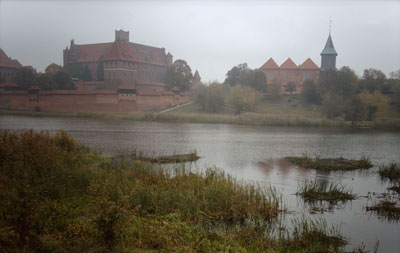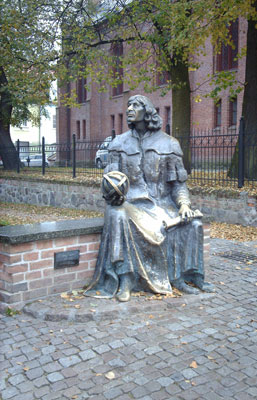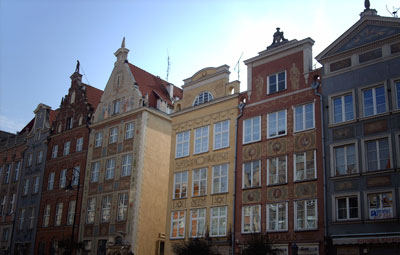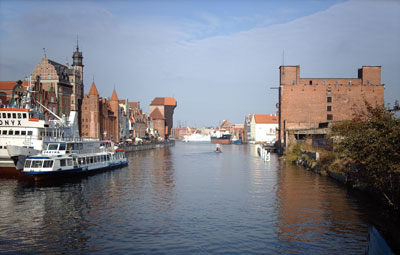Days and knights in northern Poland
by Lynn Remly, Hudson, OH
Spotting the ad in The New York Times travel section was serendipity. I had wanted to visit several sites in northern Poland for a long time, but the challenge of renting a car and driving in a country where I don’t speak the language had slowed me down. Fortunately, “Gems of Northern Poland,” a seven-day, six-night trip offered by American Travel Abroad (New York, NY & Chicago, IL; 800/228-0877, www.amta.com), agents for Orbis Travel (www.orbisincoming.com), Poland’s largest travel agency, proved to be just the boost I needed.
Getting there
As a history buff, I had been reading everything I could lay my hands on about the Hanseatic League and the Teutonic Knights, both of which figured prominently in northern Poland from the 12th to 16th centuries. In fact, it’s hard to overestimate the significance of these German entities all through the lands along the Baltic Coast, and I wanted to see evidence of their impact for myself.
To be certain I got there on time and to do some exploring on my own, I elected to spend a day in Warsaw before joining the tour. I used my United Airlines frequent-flyer miles for the flight and arrived by way of United Express and SAS, a United partner. The tour package, without air, cost $1,094 plus a single supplement of $270.
Orbis had arranged for my pickup at the airport by Alina, an English-speaking guide who is also owner of Al-Trans Travel Agency (ul. Jaworzyńska 3, Apt. 4, 00-634 Warsaw, Poland; phone 0 22 85 42 26 or 0 22 617 71 02).
As she delivered me to Hotel Novotel Warszawa Centrum (phone 48 [22] 621 0271, www.novotel.com), she suggested a couple of possibilities for my free day, but I already had planned to visit the Royal Castle to see the paintings by Canaletto, so she offered a time to pick me up for dinner (included in the tour cost) and left me to catch up on my sleep.
Castle visit
Unfortunately, the next day brought rain, sleet, high winds and three inches of snow. Since this hadn’t been forecast, it was a pretty grim day.
The Novotel was centrally located, about a 20-minute walk from the historic Old Town, so I walked up to the castle along Nowy Swiat. This elegant shopping street forms part of the Royal Way, which connects Warsaw with the country’s former capital, Kraków.
Built in the 15th century, Warsaw’s Royal Castle — located in the Plac Zamkowy at the entrance to the Old Town — was the official residence of the Polish monarchs as well as a home to parliament.
In 1939 the castle was bombed by the Germans, and during their occupation they plundered the castle before blowing it up in 1944 on Hitler’s orders. It was reconstructed by 1974, but the return and replacement of furnishings, paintings and other works of art went on until 1988.
In addition to housing the monarchy and parliament in grand style, the castle has a significant art collection, including a room full of paintings by Bernardo Bellotto, better known in Poland as Canaletto (not to be confused with his more widely recognized uncle, Giovanni Antonio Canal, also known as Canaletto).
Regarded as a master of perspective, Canaletto spent 13 years in Warsaw as a painter of panoramic cityscapes. So accurate were his 26 paintings (24 survived) that they were used as guides when the city was restored after the devastation of World War II. Admission to the castle cost 20 zloty, or $5.75.
Braving the weather
Because of the miserable weather, I decided to keep moving, making only a brief visit to St. John’s Cathedral, one of three cathedrals in the city. Originally built in the 14th century, it is one of the oldest churches in Warsaw. It also is a coronation and burial site for the Dukes of Masovia, a historic region of Poland.
Having warmed up slightly, I walked around Rynek Starego Miasta (Old Town Market Place), which I had visited on my first trip 15 years ago. It still lifted my heart. The square was laid out sometime in the late 13th or early 14th century, with lovely pastel shops and buildings surrounding the paved yard. Needless to say, it was badly damaged during WWII, and the Germans blew up what survived the Warsaw Uprising of 1944.
Using as much as possible of the original brick, Varsovians rebuilt the square, which now shelters apartments, fine shops, restaurants and taverns. The entire Old Town has been placed on UNESCO’s list of World Heritage Sites.
One of my favorite things to do there is stroll around the square and surrounding streets at dusk, when the lights come on, evoking earlier centuries.
I walked as far as the Warsaw Barbican, a semicircular fortified outpost and all that remains of the network of fortifications that once encircled the city. But, soaked through, I finally decided to cut short my touring and return to the hotel to dry out and warm up.
Stirring sights
Alina took me to dinner at Pod Samsonem (ul. Freta 3 i 5; phone 48 [22] 831 17 88), where we enjoyed a glass of Chilean wine and home-cooked Polish/Jewish food in very cozy, homelike surroundings. I am a vegetarian, but the cook had no trouble providing mushroom soup and potato dumplings, both delicious.
Though the snow had let up, it was very cold the next day, so Alina suggested indoor visits. I went to the Warsaw Rising Museum (ul. Grzybowska 79; phone 22 539 79 05, www.1944.pl), which documents the Polish Home Army’s battle against German occupation from August to October 1944. In the planning stages for two decades, the museum finally opened in 2004, coinciding with the 60th anniversary of the uprising.
The uprising was intended to last for only a few days, until the Soviet Army reached the city, but Stalin held back his troops and let the Germans pound the Poles for 63 days, until they surrendered on Oct. 3.
Exhibits include a children’s section; a B-24 Liberator with information on airdrops; sections on Nazis and Communists, and a very disturbing section on “Western Betrayal,” which documents the Allies’ dithering in Poland’s time of need. The museum is closed Tuesdays; admission is five zloty (free on Sundays) .
The Warsaw Uprising is not to be confused with the Warsaw Ghetto Uprising that started in January 1943. Arising within the Warsaw Ghetto, this uprising marked the Jewish resistance to the transport of Jews to Treblinka. The city’s Jewish population was enormous, about 700,000, and, unlike in other European capitals, the Jews lived dispersed throughout the city. During the German occupation, they were herded into a central ghetto.
From April to May 1943, Jews fomented the largest single revolt by Jews anywhere during the Holocaust, but their efforts were doomed and the revolt was crushed by German troops. I asked Alina to drive by the Umschlagplatz (ul. Stawki 10), where a modern memorial stands on the site of the railroad line that transported people to the Treblinka extermination camp. It seemed desolate, despite traffic everywhere; some places simply recall the horror of an earlier time without fanfare.
Joining the group
My “Gems of Northern Poland” tour included breakfast each morning at the hotel, four lunches and two dinners, all of which were excellent. The agency tried hard to ensure that the restaurants and taverns visited were old-fashioned eateries in the Polish style, serving traditional food. For me, this was a plus, since I had never sampled much in the way of Polish food and wanted to try it.
Though we usually were left on our own for dinner, I can guarantee that anyone who has finished a Polish lunch will have no need for an evening meal. I would recommend any of the restaurants we visited.
After my morning of touring solo, I joined eight other travelers (who had been visiting southern Poland in even worse weather) for lunch at Karczma u Dedka (Al. Zieleniecka 6/8; phone 48 [22] 619 47 52). Located outside the downtown area, the restaurant is pleasantly situated in lakeside Skaryszewski Park.
Fortunately, the weather had cleared enough for our trip to Toruń, an important center of the Teutonic Knights, so after lunch we piled into a Mercedes bus for the 190-mile ride to our hotel there, the Mercure Helios Toruń (ul. 1/3 Kraszewskiego; phone 48 [56] 619 6550, www.accorhotels.com). My room looked out over the city walls and castle ramparts, all romantically lighted at night — a promise of things to come the next day.
Touring Toruń
The Order of the Teutonic Knights of St. Mary’s Hospital in Jerusalem is a German Roman Catholic religious order formed at the end of the 12th century to assist Catholics on their pilgrimages to the Holy Land.
Like so many similar orders founded during the Crusades, the Teutonic Knights established hospitals to care for the sick and injured, but they were also a crusading military order. They later became a secular order, one that still exists today and now includes women. Headquartered in Vienna, they perform charitable functions.
Our local guide, Jan, led us on a walking tour of Toruń’s Old Town, which is surrounded by double walls divided by a moat. We walked along the walls, admiring the granaries huddled near the gates that led down to the Vistula River, whence ships would convey the local produce to the Baltic and beyond. In fact, the city was a prominent member of the Hanseatic League, the alliance of trading cities and their guilds that enjoyed a virtual commercial monopoly from the Baltic to the North Sea.
The Gothic Old City Town Hall, Gothic burghers’ houses and the medieval Leaning Tower, still stable after its initial lurch off the vertical, gave the feel of the town’s antiquity and prosperity.
Only ruins remain of the Knights’ Castle, however, which angry locals destroyed after the Order was driven out. The only part that remains intact is the Latrine Tower, a surprising structure devoted to hygiene.
Toruń is also known as the home of Nicolaus Copernicus and as a center of gingerbread making. We admired the statue of Copernicus on the Town Square and walked by the university named after him. A quick, aromatic visit to a gingerbread shop rounded out our tour.
Jan explained that some gingerbread is baked as hard as a rock, in various decorative forms, in order to be preserved for show; the other kind is baked softer for immediate enjoyment. Woe to the teeth of those who confuse them! (Incidentally, Jan told us that all of the town’s gingerbread is produced at the same factory, so point of purchase doesn’t matter.)
We had lunch at Hotel Karczma Spichrz (ul. Mostowa 1; phone 48 056 65 71 140), occupying one of the former granaries near the Vistula River and the Mostowa Gate. Once again, the management accommodated my request for a vegetarian meal, serving me a huge salad and fried cheese.
Poor planning
From Toruń we traveled north the next day to the Tri-City area, which includes Gdynia, Sopot and Gdańsk. We stayed at Hotel Orbis Gdynia (ul. Armii Krajowej 22; phone 48 [58] 666 3040, www.accorhotels.com), which offered a splendid view of the Baltic Sea but little else.
As is the case in many countries, the hotels we visited seemed to be owned by or at least affiliated with the travel agency, explaining why we stayed there but not guaranteeing quality. We all found the hotel to be shabby, overheated and noisy (due in part to concert facilities across the street). It is not one that I would recommend.
Unlike Toruń’s, Gdynia’s history is entirely recent. The town was developed in the 1920s as an alternative to the port of Gdańsk, which was under German control. It is therefore very new and has none of the charm of cities like Toruń or Gdańsk.
In my opinion, the town offers simply nothing to the visitor and a lot to repel him or her. In addition, we wasted valuable time driving the 40 to 50 minutes from Gdynia to Gdańsk and back; staying in that city would have allowed us to see more of its many, many attractions.
Day tripping
After breakfast, we drove to Sopot, a resort town on the Baltic. The romantic origins of the town are rooted in Napoleon’s retreat from Moscow in 1812, during which one of his medical personnel, Jean Georg Haffner, supposedly fell in love with a local girl. At the same time, he recognized the health-giving benefits of the sea air and local hot springs. Turning entrepreneur, Haffner started a health spa, which has since become a major tourist destination.
Every season the rich and famous crowd the iconic Grand Hotel and other area hostelries to take advantage of summer music festivals as well as the health centers.
We also stopped to view the Westerplatte monument, which marked the first battle of World War II. The Westerplatte peninsula saw the first clash between Polish and German forces during Hitler’s invasion of Poland, a small force of Polish soldiers holding off the invading Wehrmacht for a week before having to surrender.
Later we stopped at Gdańsk’s Oliwa Cathedral for a tour and 20-minute organ concert. At about 321 feet, it is the longest Cistercian church in Poland, but visitors and musicians come from everywhere to enjoy its 18th-century organ, which can reproduce tones as different as bird calls and animal cries.
Lunch was at the Restauracja Gdańska (ul. S´w. Ducha 16/24; phone/fax 058 305 76 71, www.gdanska.pl). By this time, the day was almost gone, and we arrived in Gdańsk far too late to really appreciate the city.
We took a brisk walking tour of the Long Market, from the Green Gate to the Town Hall, taking in some of the highlights such as Artus Court, a mansion that served as a symbol of the city’s power in the 16th and 17th centuries. It was founded as a meeting place for merchants and dignitaries and named for King Arthur and his Knights of the Round Table to give romance and a hint of history to their dealings.
Legacy of the knights
The Teutonic Knights were not famous for their warm and fuzzy approach to affairs — especially apparent to anyone who recalls the scene from Sergei Eisenstein’s 1938 classic film “Alexander Nevsky,” where the pot-helmed knights cheerfully kill babies before they are, thankfully, swallowed up by the icy waters of Lake Peipus. But, as our guide pointed out, they weren’t all bad.
From a distance, we saw the Radunia Canal, the knights’ 1338 project to facilitate shipping, but skipped the knights’ Great Mill, the largest industrial plant in medieval Europe.
Similarly, we saw their Great Crane on the waterfront from far, far away. It was constructed by the knights to unload cargo from ships and was run by human leg power, driving a sort of squirrel-cage winch. Our guide explained that the crane gave rise to the first sort of social security, since the men who had powered the crane were almost incapable of walking after many years of work and were given a pension.
Though we had skimmed the knights’ engineering accomplishments, it was clear that they did promote agriculture and trade — even if they were the principal beneficiaries.
Gdańsk is the center of the amber industry in Poland, a lucrative industry controlled, incidentally, by the Teutonic Knights in the Middle Ages. We went for an obligatory demonstration of amber polishing at a local store, then were left to purchase amber jewelry or spend a few minutes wandering in the main market square.
The city was 90% destroyed in World War II but has since been reconstructed to its medieval-Renaissance glory. Its town center seems to go on and on, with street after street of beautiful architecture. I was very sorry not to have any time at all for exploration and immediately began making mental plans to return.
Malbork Castle
We traveled the next day to Malbork Castle, built by the Teutonic Knights as their principal seat in the late 13th and early 14th centuries. The largest brick castle in Europe, it runs over 3,000 feet on one side and comprises the High, Middle and Lower castles. Because the building was extensively restored in the 19th century, it represents a romanticized Gothic structure, but it is very impressive and very beautiful.
Though the friars who were of the Order were sworn to poverty and obedience as well as chastity, their lifestyle, as represented in the building, was one of upper-class convenience, even comfort. An enormous fireplace served the kitchens but also provided central heating for the rooms above, as evidenced by vents in the pillars and floor.
Malbork was functional, including quarters, two refectories, a Palace of the Grand Master of the Order, farm buildings, an armory and so on, but it was meant to impress. Indeed, through its entire history, the massive building was never taken by force, though it was badly damaged in WWII.
We ate at one of the restaurants in the castle precincts, Restauracja Zamkowa in Hotel Zamek (77-100 Bytów, ul. Zamkowa 2; phone/fax 48 [59] 822 20 94, www.hotelzamek.com.pl), again, a Polish restaurant with traditional foods.
Meals to remember
From Malbork we drove to Olsztyn for a walking tour with a local guide. We then settled in at the Novotel Olsztyn (ul. Sielska Street 4a; phone 48 89 522 0500) before wandering along the lakeside. We were in the region of the Masurian Lakes, a popular resort area, but it was rather empty at that time of year.
Later we drove out of town for dinner and a (very long) folkloric performance at a charming tavern/restaurant. Throughout the trip, I was glad to be able to try Polish specialties. Here I was offered, among other things, prune soup, which was served hot and contained noodles. One of our group was of Polish extraction and said that she often made it, but it was new to me — and delicious.
The next day took us back to Warsaw and the inevitable separations. We shared a final lunch at an Old Town restaurant and brewry, BrowArmia Królewska (ul. Królewska 1; phone 022 826 54 55, www.browarmia.pl), where I enjoyed a vast platter of different pierogi (with fillings such as mushrooms, potatoes and cheese). Though Poland is not known for its wines, its breweries produce a wide variety of fine beers.
I had elected to stay in Warsaw for an extra day for last-minute touring and shopping, and I walked to the Old Town Square one last time to drink in the medieval ambience as the street lamps were lit at night. Looking at amber jewelry glittering in the lighted shop windows, I could only think about the complex history of Poland — and begin planning my next trip.






